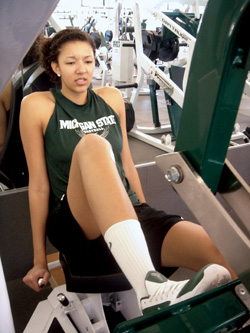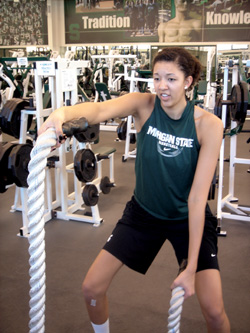Powerline: Helping train women, injured athletes
Just as with all other aspects of athletics, a comprehensive strength-training program has numerous special-needs situations that require more than just a passing glance.
This Powerline installment takes a closer look at issues that envelop two of the more prominent ones: Female strength training and the injured athlete.
Female strength training
There was a time in the not-too-distant past when female strength training was clouded with a litany of misconceptions and silly stereotypes. The fallacious thinking of the time was unfortunate, as a large number of female athletes were deprived of the opportunity to improve their performance and possibly reduce the likelihood or severity of injuries.
I can remember the days when antiquated gender and social stigmas served to stymie the advancement of female strength training to the point of absurdity. Much of the mainstream lifting community at the time perceived lifting and strength training as a males only endeavor.
Unsubstantiated proclamations included: Loss of flexibility, deteriorating athleticism, and bulky, unattractive muscles. Fortunately, much of that archaic mentality has been abated.
Females who engage in strength training — in conjunction with sound nutritional and sport-specific conditioning practices — should lose some body fat and make relative increases in muscle size. Total body weight may fluctuate slightly as a result but is often unaffected. What usually happens is welcomed by the athletes: A firmer, more athletic physique.
The majority of females do not produce enough of the male endogenous hormone, testosterone, to develop large, bulky muscles. Also, in many cases, they do not possess the high percentage of fast-twitch muscle fibers — those that are larger and more receptive to growth from progressive resistance training — as their male counterparts.
From an anatomical standpoint, many females are smaller in stature, inherit less overall muscle tissue and have shorter muscle bellies (which have less size potential) than males.
All of the above variables combined make it highly unlikely that females who partake in a year-round strength-training program will suddenly morph into offensive tackles.
Why should female athletes be actively involved in a year-round strength-training program? Well, for all of the same reasons that apply to male athletes:
- To increase flexibility (that’s right, proper strength training improves, not decreases, flexibility).
- To increase joint integrity, which can lessen the incidence or severity of many injuries. This is an especially crucial area for females due to their high rates of joint-related injuries, most notably the knee and ACL tears.
- To improve overall force and power output when performing athletic skills.
- To assist with speed and quickness development.
- To increase bone mineral density; a process that leads to stronger, healthier bones, and aid in staving-off the onset of osteoporosis when good training and nutritional habits are maintained throughout life.
- To make improvements, albeit modest, in blood lipid profiles (lowering of LDL, the so-called bad cholesterol, and increasing HDL, or good cholesterol). Also, strength training can increase glucose utilization, which can reduce the risk of diabetes.
Female athletes and their coaches should now know that female and male muscle tissues are basically uniform. This validates the precept that the ability of muscle tissue to gain strength and produce power is independent of gender. And, based upon relative strength gains (i.e., when areas of cross sectional muscle tissue are compared), research has shown that strength gain potential is very close between males and females.
Unfortunately, those of us at the collegiate level still encounter far too many female athletes who were not afforded the opportunity to strength train while in high school. For those of you who coach female athletes, I strongly urge you to place them in a structured, organized, year-round strength-training program.
Working with injured athlete
Sports injuries are unenviable, yet inevitable. Along with the obvious physical and mental dilemmas brought to bear on the athlete, coaches tend to become disconcerted in these situations regarding a plan of action.

The first order of business is to bring in all of the involved parties for consultation and deliberation. The athlete, parents, primary care physician, athletic trainer, strength and conditioning coach and any other involved personnel (e.g., an outsourced physical therapist) must come to a consensus on the rehabilitation and training procedures to be implemented.
A plan for the initial treatment, and the subsequent middle and late phases of the rehabilitation process, should be drafted. Even though everything is subject to change and design flexibility must be inserted to allow for seamless transition, it’s important to have a starting point and a solid idea of where to go from there.
The strength and conditioning coach is usually called upon for input and expertise during the latter part of the first stage of rehab for the injury site, and is responsible for devising a plan for all other unaffected areas of the body throughout the entire process. It’s important to keep healthy, strong muscles and joint compartments progressing without interruption as much as possible.
This includes — when the green light is given from the physician and athletic trainer — strengthening the areas proximal (above) and distal (below) to the injury site. And, even when an entire limb must be kept relatively immobile, the opposite limb should be trained, if it can be executed with no adverse affects to injured side.
Doing so enables a process known as cross-transfer, or indirect-transfer, which essentially initiates some minimal strength gains in the injured limb via neural input. Even though the improvement is very small in comparison to the uninjured limb, any type of stimulation during the rehabilitation period can pay dividends in slowing the effects of muscle disuse.
Obviously, permission must be granted from the medical and sports medicine staffs to resume progressive resistance training with the injured limb or area. The strength and conditioning coachs responsibilities now become more involved and require some thought and innovation.
Here are some suggestions and coaching points:
- Manual resistance always provides a good starting point in determining strength deficits along the strength curve and movement path (e.g., such as during the raising and lowering phase of a lateral arm abduction or adduction). When a deficit, or break, in strength is noted, it should be discussed with the medical staff for troubleshooting purposes.
- Since the quality of the involved weight loads is usually severely diminished as a result of the injury, higher reps with lighter weight or increased time under load (TUL) is needed for appreciable muscle stimulation.
- When quality is compromised, quantity (in either total reps or TUL) should be heightened.
- Unilateral work with dumbbells, kettlebells or machines provides a viable option and a workable starting point for recording progress. Progression comes at a slower pace than usual, but it’s still vitally important to track reps, weight used and increases in TUL to verify strength improvements.
Final rep
Keep in mind that the athlete has a new starting point, and it’s most likely far below what he or she is accustomed to performing. Encouragement and mentoring throughout the entire process are paramount, as the mental psyche of the athlete needs every positive nugget of motivation available to push through each session and envision some light at the end of the tunnel.
As soon as light sport and position-specific drills can be eased into, it does wonders in lifting the athletes spirits and providing him or her with the hope of an imminent return to the playing field.


